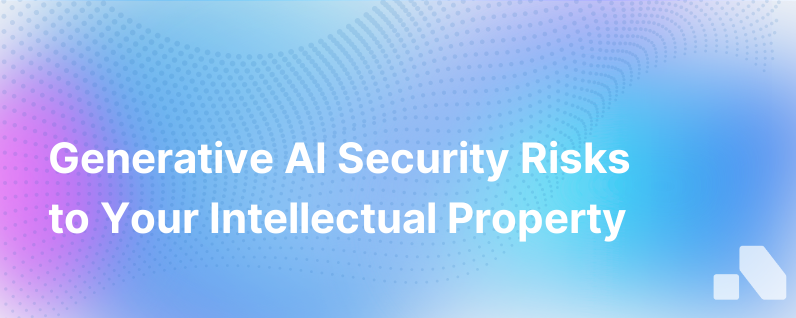
In the digital age, where the creation and distribution of content are as limitless as the internet itself, intellectual property (IP) assumes paramount importance. It signifies not only the cornerstone of branding and product development but also the hard-earned innovation capital of an organization. The advent of Generative AI has opened Pandora's box of possibilities, from automating mundane tasks to concocting sophisticated designs. However, this dazzling progress comes with its own dark clouds – particularly concerning the security of generative AI systems and the protection of IP.
The Vulnerable Intersection of Generative AI and IP
Generative AI, a term badge for artificial intelligence that can generate new content based on learned data patterns, has the potential to innovate how we approach IP creation. Industries evolving from this innovation are witnessing a surge in AI-generated literature, music, art, and design. While this exemplifies the power AI harbors, it also raises alarm over the safeguards in place to protect proprietary information from being misappropriated or mishandled by AI systems.
Understanding the Risks
Here's a nuanced exploration of how lax security protocols in generative AI platforms could spell disaster for your intellectual property:
Data Poaching and Involuntary Training
AI models, particularly those involved in generative processes, require extensive datasets to train on. If not properly secured, these models could inadvertently consume proprietary data, leading to the generation of derivative works that dilute or appropriate your unique IP. In effect, each generated piece that mirrors your IP becomes a leak, a bleed of competitive advantage.
Erosion of Trade Secrets
For many companies, trade secrets are the bedrock of their competitive edge. Generative AI, often designed to identify patterns and replicate processes, could inadvertently expose these secrets if security isn't airtight. Imagine your proprietary algorithms or your unique blend of ingredients seeping into the public domain – it's akin to leaving the blueprint to your success on a park bench.
Automated IP Infringement
The AI-driven frameworks are monuments to automation efficiency. However, without rigorous ethical programming and legal compliance checks, they can also become prolific creators of infringing content. This is not so much a bug as a latent feature of an AI that hasn't been meticulously corralled to respect the bounds of existing IP laws.
Brand Misrepresentation
Generative AI systems lacking robust security measures can be hacked or manipulated to generate content incongruent with a brand's values or guidelines, instigating confusion and deteriorating brand identity. This electronic doppelganger not only inflicts immediate reputational damage but also undermines years of brand building.
Ownership Ambiguity
The crossroads of AI-generated content and IP ownership is fraught with legal ambiguity. If generative AI freely manipulates or re-creates content based on IP without clear permissions or protections, this not only creates a legal minefield but also devalues the concept of IP, questioning the very ownership of machine-generated creations.
Fortifying Generative AI Security: A Primer
The protection of IP in the context of Generative AI calls for a multi-layered defense strategy that encompasses technical, legal, and ethical dimensions:
Secure Data Management
Reinforcing data access protocols ensures that only authorized datasets feed the AI. Encrypting training data, scrutinizing sources for authenticity and rights, and deploying intrusion detection systems can substantially mitigate involuntary data poaching.
Access Control Layering
Implementing stratified access controls within the AI ecosystems can act as fortified gates that keep IP elements away from unauthorized algorithmic scrutiny, ensuring your trade secrets remain undiscovered jewels.
Ethical AI Frameworks
Programming ethics into AI isn't just a philosophical endeavor; it's a necessity. Developing AI that inherently understands and abides by IP laws can prevent many issues stemming from automated IP infringement.
Continuous Monitoring and Auditing
Systems that consistently monitor generative outputs and audit the procedural integrity can flag anomalies or potential security breaches, maintaining brand consistency, and coherent representation.
Legal Clarity
Explicit contracts detailing data usage, ownership rights, and post-generation responsibilities can serve as legal bulwarks against IP infringement. It ensures the generated outputs do not conflict with existing IP laws.
Closing Thoughts
As the rings of innovation expand with generative AI, organizations must be vigilant and proactive in securing their proprietary assets. Poor generative AI security isn't merely a technical issue; it's a caveat that calls into question the future of IP as we know it. The interplay between AI and IP should be one of symbiotic harmony, not predatory erosion.
Aligning generative AI with your organization’s IP sanctity is both a safeguard and a competitive imperative. In doing so, it not only champions the sanctity of intellectual assets but also steers generative AI towards a future where innovation flourishes without the specter of security risks.
To harness the true power of generative AI while securing your intellectual property, it pays to invest in security. Platforms like Aomni prioritize data security and ethical AI usage, ensuring that when you leverage AI's potential, it works for you – not against you. By protecting your IP with the diligence it deserves, you can rest assured that the generative advances propel your innovation, reputation, and brand forward, securely and sustainably.